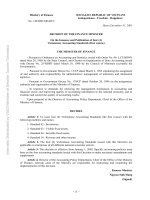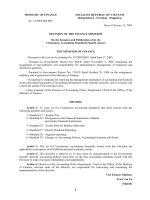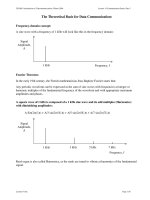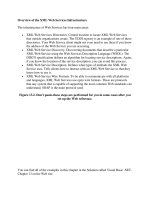Tài liệu Implementation of the Diabetes Practice Guideline in the Army Medical Department - Final Evaluation ppt
Bạn đang xem bản rút gọn của tài liệu. Xem và tải ngay bản đầy đủ của tài liệu tại đây (478.1 KB, 182 trang )
This document and trademark(s) contained herein are protected by law
as indicated in a notice appearing later in this work. This electronic
representation of RAND intellectual property is provided for non-
commercial use only. Permission is required from RAND to reproduce, or
reuse in another form, any of our research documents.
Limited Electronic Distribution Rights
Visit RAND at www.rand.org
Explore RAND Arroyo Center
View document details
For More Information
This PDF document was made available
from www.rand.org as a public service of
the RAND Corporation.
6
Jump down to document
THE ARTS
CHILD POLICY
CIVIL JUSTICE
EDUCATION
ENERGY AND ENVIRONMENT
HEALTH AND HEALTH CARE
INTERNATIONAL AFFAIRS
NATIONAL SECURITY
POPULATION AND AGING
PUBLIC SAFETY
SCIENCE AND TECHNOLOGY
SUBSTANCE ABUSE
TERRORISM AND
HOMELAND SECURITY
TRANSPORTATION AND
INFRASTRUCTURE
WORKFORCE AND WORKPLACE
The RAND Corporation is a nonprofit
research organization providing
objective analysis and effective
solutions that address the challenges
facing the public and private sectors
around the world.
Purchase this document
Browse Books & Publications
Make a charitable contribution
Support RAND
This product is part of the RAND Corporation monograph series.
RAND monographs present major research findings that address the
challenges facing the public and private sectors. All RAND mono-
graphs undergo rigorous peer review to ensure high standards for
research quality and objectivity.
Prepared for the United States Army
Approved for public release; distribution unlimited
Final Evaluation
Implementation
of the Diabetes
Practice Guideline
in the Army Medical
Department
Donna O. Farley
Georges Vernez
Kathryn J. Dolter
Suzanne Pieklik
Wenli Tu
J. Scott Ashwood
Shan Cretin
The RAND Corporation is a nonprofit research organization providing
objective analysis and effective solutions that address the challenges
facing the public and private sectors around the world. RAND’s
publications do not necessarily reflect the opinions of its research clients
and sponsors.
R
®
is a registered trademark.
© Copyright 2005 RAND Corporation
All rights reserved. No part of this book may be reproduced in any
form by any electronic or mechanical means (including photocopying,
recording, or information storage and retrieval) without permission in
writing from RAND.
Published 2005 by the RAND Corporation
1776 Main Street, P.O. Box 2138, Santa Monica, CA 90407-2138
1200 South Hayes Street, Arlington, VA 22202-5050
201 North Craig Street, Suite 202, Pittsburgh, PA 15213-1516
RAND URL: />To order RAND documents or to obtain additional information, contact
Distribution Services: Telephone: (310) 451-7002;
Fax: (310) 451-6915; Email:
Library of Congress Cataloging-in-Publication Data
Implementation of the diabetes practice guideline in the Army Medical Department : final
evaluation / Donna O. Farley [et al.].
p. cm.
Includes bibliographical references.
“MG-277.”
ISBN 0-8330-3769-2 (pbk.)
1. Diabetes—Treatment—Standards—United States. 2. Military hospitals—United
States. 3. Medicine, Military—United States. 4. United States. Army Medical Dept. I.
Farley, Donna.
RA645.D5I476 2005
362.196'462'00973—dc22
2005005240
The research described in this report was sponsored by the United States
Army under Contract No. DASW01-01-C-0003.
iii
Preface
The RAND Corporation has worked with the Army Medical
Department (AMEDD) on a project entitled “Implementing Clinical
Practice Guidelines in the Army Medical System.” This project was
undertaken to assist the AMEDD in developing and testing methods
to effectively implement clinical practice guidelines in Army military
treatment facilities (MTFs), with the goal being to achieve consistent
and quality clinical practices across the Army health system. Three
demonstrations were conducted to test and refine methods before
embarking on full guideline implementation across the Army health
system. These demonstrations tested use of guidelines for primary
care management of low back pain, asthma, and diabetes.
This report presents the final findings from the RAND evalua-
tion of the diabetes practice guideline demonstration, which was
conducted in 2000 and 2001. The evaluation included both an
assessment of the implementation process and a quantitative analysis
of changes in clinical practices. The quantitative analysis was per-
formed to document the extent to which intended actions were actu-
ally implemented by the MTFs, assess short-term effects on clinical
practices, develop and test metrics and measurement methods that
can be adopted by the AMEDD for routine monitoring of progress,
and assess the quality and limitations of available data for monitoring
practice improvements and clinical outcomes. Recommendations for
future actions by the AMEDD are presented.
This report is one of three final reports being generated in this
project. It should be of interest to anyone concerned with military
iv Implementation of the Diabetes Practice Guideline in AMEDD
medical systems and policies. Similar reports were prepared from the
demonstrations for the low back pain and asthma practice guidelines.
This research was sponsored by the U.S. Army Surgeon General.
It was conducted jointly by the RAND Arroyo Center, a federally
funded research and development center sponsored by the U.S.
Army, and by the RAND Center for Military Health Policy Research.
v
Contents
Preface iii
Figures
ix
Tables
xi
Summary
xv
Acknowledgments
xxix
Abbreviations
xxxi
CHAPTER ONE
Introduction 1
The DoD/VA Guideline Adaptation Process
3
Overview of the Diabetes Practice Guideline
4
Expected Effects on Health-Care Practices
4
A Systems Approach to Implementation
7
Basic Implementation Strategy
8
Six Critical Success Factors
9
The AMEDD Guideline Implementation Process
10
The Demonstration Sites
11
The RAND Evaluation
13
Organization of This Report
14
CHAPTER TWO
Methods and Data 15
Implementation Process Evaluation Methods
16
Evaluation Site Visits
17
Other Information Collection Activities
18
vi Implementation of the Diabetes Practice Guideline in AMEDD
Outcome Evaluation 19
Evaluation Design
20
Choice of Demonstration and Control Sites
20
Data Sources
21
The Diabetic Population
21
Outcome Measures
23
Definitions of Other Key Variables
28
Data Collection
30
Analytic Methods
30
Estimating the Costs of Care
31
CHAPTER THREE
Diabetic Population and Practices at the Baseline 35
The Diabetic Population Served by Army MTFs
35
Enrollment Status and Use of MTF Services
37
Baseline Performance on Diabetes Care Measures
39
Distributions of MTFs on Diabetes Measures
41
Summary
44
CHAPTER FOUR
The Guideline Implementation Process 47
MEDCOM Support
48
The Kickoff Conference
49
The Diabetes Toolkit
49
Information Exchange
52
Structure and Support at the MTFs
53
The MTF Environment
53
Support for the Demonstration
54
Implementation Activities and Progress
56
Implementation Strategies
56
The Implementation Process and Activities
57
Highlights of Implementation by the TRICARE Senior Prime
Demonstration Sites
60
Actions Taken to Implement Practice Improvements
61
Challenges Stemming from External Factors
61
Contents vii
Lessons Learned: Conclusions and Recommendations Regarding
Implementation
62
MEDCOM Support
62
Support at the MTF
63
CHAPTER FIVE
Effects of Guideline Implementation 65
Performance Changes Reported by MTFs
65
Analysis of Effects on Service Delivery
67
Use of Primary Care Services
68
Use of Oral Hypoglycemic Agents to Control Blood Sugar
70
Annual Eye Examinations
72
Use of ER Services
74
Use of Hospital Inpatient Services
75
Estimated Costs of Care for MTFs in the Study
77
Overall Costs of MTF Services
80
Variations in Costs Across Facilities
84
Summary
86
CHAPTER SIX
Syntheses of Findings from the Demonstration 89
Implications of Findings on Service Use and Cost
90
Guideline Implementation: Performance on Critical Success Factors
95
Study Limitations
97
Recommendations
98
Implementation
98
Benchmarking of MTF Performance
99
Outcomes Measurement
99
Costs
102
APPENDIX
A. Evaluation Methodology 103
B. Analyses of Diabetes Metrics
127
C. Graphic Representation of Baseline Service Use Data
141
Bibliography
145
ix
Figures
1.1. Diagram of the Demonstration Project 2
1.2. Matrix of Implementation Outcomes
8
1.3. Guideline Implementation Process
11
2.1. Evaluation Timeline
21
3.1. Baseline Annual Primary Care Visits per 100 Diabetes Patients
for Insulin and Non–Insulin Users, Total and by Site
42
3.2. Baseline Percentages of Non–Insulin Using Diabetic Patients
Treated with Oral Hypoglycemic Agents, Total and by Site
43
3.3. Baseline Percentage of Diabetic Patients with at Least One Eye
Examination Annually, Total and by Site
44
3.4. Baseline Annual ER Visits per 100 Diabetic Patients, Total and
by Site
45
3.5. Baseline Annual Inpatient Stays per 100 Diabetes Patients, Total
and by Site
45
5.1. Trends in Primary Care Visits for All Diabetic Patients, by
Demonstration and Control Sites
69
5.2. Trends in Primary Care Visits for Diabetic Patients, by Insulin
User or Nonuser and Demonstration and Control Sites
70
5.3. Percentage of Non–Insulin Dependent Diabetic Patients Who
Filled Prescriptions for Oral Hypoglycemic Agents, by
Demonstration and Control Sites
71
5.4. Percentage of Diabetic Patients with at Least One Eye
Examination Annually, for Demonstration and Control
MTFs
73
x Implementation of the Diabetes Practice Guideline in AMEDD
5.5. Trends in ER Visits per 100 Diabetic Patients, All Demonstration
and Control Sites
74
5.6. Trends in ER Visits per 100 Diabetic Patients, Demonstration and
Control Sites
75
5.7. Trends in Diabetes-Related or Other Hospital Inpatient Stays
per 100 Diabetic Patients, Demonstration and Control Sites
76
5.8. Trends in Total Hospital Inpatient Stays per 100 Diabetic Patients,
Demonstration and Control Sites
77
5.9. Composition of MTF Total Costs for Enrollee and Nonenrollee
Diabetic Patients for Demonstration and Control Sites, by
Study Year
78
5.10. Estimated Total MTF Cost per Patient for MTF Enrollees and
Other Users, Demonstration and Control Sites, by Study
Year
79
A.1. A System View of Guideline Implementation
104
C.1. Outpatient and ER Visits to MTF and Network Providers by
Patient Enrollment Status and by Study Year
141
C.2. Outpatient and ER Visits of MTF and Network Enrollees and
Nonenrollees to MTF and Network Providers, by Provider Type
and Study Year
142
C.3. Enrollment Status of Patients for Inpatient Admissions at MTFs
and Network Providers, by Study Year
143
C.4. Inpatient Admissions at MTFs and Network Providers, by
Enrollment Status of Patients and Study Year
144
xi
Tables
1.1. Key Elements of the DoD/VA Diabetes Practice Guideline 5
1.2. Changes in Clinical Practices Predicted by Practice Guideline
Implementation
6
1.3. Profiles of the Military Treatment Facilities Participating in the
Diabetes Guideline Demonstration
12
2.1. Expected Effects of Proactive Diabetes Care Management
20
2.2. Sources of Data for Analyses
22
2.3. Diabetic Patient Sample Sizes for the Demonstration and Control
MTFs, by Study Year
24
2.4. Indicators Used to Measure Effects on Service Utilization
Related to Implementation of the DoD/VA Diabetes Practice
Guideline
25
2.5. Counts of Clinical Laboratory Records Extracted by DoD from
the MTF CHCS Data, by Month and Year
26
2.6. Comparison of Diabetes Type Reported in Diagnostic Codes
and Use of Insulin, Study Year One
27
3.1. Identification of the Diabetic Population Served by Army
MTFs, by Study Year
36
3.2. Demographic Characteristics of the Diabetic Population Served
by Army MTFs, by Study Year
37
3.3. Enrollment Status for Patients Receiving Diabetes Care at Army
MTFs or Network Providers, by Study Year
39
3.4. Diabetic Population Using the Demonstration and Control
MTFs, by Study Year
40
3.5. Rationale for Diabetes Indicators Provided by the Guideline
41
xii Implementation of the Diabetes Practice Guideline in AMEDD
4.1. Contents of the Diabetes Toolkit 50
5.1. DQIP and Other Diabetes Indicators Monitored by the
Demonstration MTFs
66
5.2. Estimated MTF Costs for Diabetes Patients Enrolled at the
Demonstration and Control MTFs, Study Years One
and Two
81
5.3. Estimated MTF Costs for Nonenrollee Diabetes Patients Using
Care at the Demonstration and Control MTFs, Study Years One
and Two
83
5.4. Estimated Costs of Outpatient Services for Diabetes Patients
Enrolled at the Demonstration and Control Sites, Study Years
One and Two
85
5.5. Estimated Costs of Inpatient Services for Diabetes Patients
Enrolled at the Demonstration and Control Sites, Study Years
One and Two
85
A.1. Dimensions Addressed by the Process Evaluation
105
A.2. Dimensions Addressed by the Process Evaluation Data Collection
Methods
106
B.1. Average Annualized Primary Care Visit Rates per 100 Patients
for All Diabetic Patients, by MTF and Quarter
129
B.2. Average Annualized Primary Care Visit Rates per 100 Patients
for Non–Insulin User Diabetic Patients, by MTF and
Quarter
129
B.3. Ordered Logistic Regression Model of Estimated Guideline
Effects on Number of Primary Care Visits per Diabetic
Patient
130
B.4. Percentage of Non–Insulin Dependent Diabetic Patients
Prescribed Oral Hypoglycemic Agents, by Demonstration and
Control Sites and Year
131
B.5. Logistic Regression Model of Estimated Guideline Effects on
Number of Non–Insulin Dependent Diabetic Patients with
Other Medication
132
B.6. Comparison of Effect of Demonstration on Regression
Coefficients and Odds Ratios for Use of Other Medications to
Control Glycemia by Noninsulin Patients
133
Tables xiii
B.7. Percentage of Diabetic Patients with a Diabetes-Related Annual
Eye Examination, by MTF and Year
133
B.8. Logistic Regression Model of Estimated Guideline Effects on
Number of Diabetic Patients with Annual Eye
Examinations
134
B.9. Average Annualized ER Visit Rates per 100 Diabetic Patients,
by Demonstration and Control Sites and Quarter
135
B.10. Logistic Regression Model of Estimated Guideline Effects on
Number of ER Visits per Diabetic Patient, All Demonstration
and Control Sites
136
B.11. Logistic Regression Model of Estimated Guideline Effects on
Number of ER Visits per Diabetic Patient, Excluding One
Demonstration Site
137
B.12. Average Number of Total Hospitalization per 100 Diabetic
Patients, by Demonstration and Control Sites and Quarter
137
B.13. Average Number of Diabetes-Related Hospitalizations per 100
Diabetic Patients, by Demonstration and Control Sites and
Quarter
138
B.14. Ordered Logistic Regression Model of Estimated Guideline Effects
on Number of Hospitalization per Diabetic Patient
139
xv
Summary
Background
The Department of Defense (DoD) and Department of Veterans
Affairs (VA) initiated a collaborative project in early 1998 to establish
a single standard of care in the military and VA health systems. This
initiative established evidence-based clinical practice guidelines for
selected conditions that would be applied in all DoD and VA health
facilities. Each practice guideline is a statement of best practices for
the management and treatment of the health condition it addresses.
For each guideline, the DoD/VA Working Group designated an
expert panel to develop the guideline contents and relevant metrics,
which were made available for use by the military services and VA
health-care facilities.
The Army Medical Department (AMEDD) has made a com-
mitment to establishing a structure and process to support its military
treatment facilities (MTFs) in implementing evidence-based practice
guidelines with the goal of achieving best practices that reduce varia-
tion and enhance quality of medical care. The AMEDD contracted
with RAND to work as a partner in the development and testing of
guideline implementation methods for ultimate application to an
Army-wide guideline program.
Taking the approach of testing new methods on a small scale,
AMEDD fielded three demonstrations over a two-year period, each
testing different clinical practice guidelines. All three of the practice
guidelines—for lower back pain, asthma, and diabetes—were estab-
lished collaboratively by the VA and DoD. This report presents the
xvi Implementation of the Diabetes Practice Guideline in AMEDD
results from a RAND evaluation of the diabetes practice guideline
demonstration. The principal emphasis of the practice guideline for
primary care management of diabetes was on effective management of
blood-sugar levels with the goal of preventing short-term complica-
tions and long-term effects on organ systems.
The key elements of the Diabetes Practice Guideline were the
following:
• patient evaluation,
• achieving and maintaining glycemic control,
• patient education and counseling, and
• early detection and management of diabetic complications.
Approach
AMEDD began the demonstration process in AMEDD’s Western
Region with a kickoff meeting in December 1999 (implementation
processes and tools are summarized in the list below). Two MTFs
participated in the demonstration as designed: Madigan Army Medi-
cal Center (AMC), Fort Lewis, Washington, a large, urban specialty
medical center, and Bassett Army Community Hospital (ACH), Fort
Wainwright, Alaska, a small hospital at a remote outpost. Three other
Army MTFs concurrently implemented the diabetes guideline in a
separate demonstration.
1
Data for all five MTFs were included in the
evaluation of guideline effects.
The following processes and tools were used in guideline
implementation:
• the practice guideline and metrics,
____________
1
In this three-year demonstration of a program called TRICARE Senior Prime, DoD con-
tracted with Medicare to offer Medicare managed-care plans in six locations for DoD benefi-
ciaries who also were Medicare-eligible. One participation requirement for the Senior Prime
plans was to implement a quality improvement initiative; diabetes care was chosen. The three
sites for which data were included in this report were Brooke AMC at Fort Sam Houston,
Texas, Evans ACH at Fort Carson, Colorado, and Reynolds ACH at Fort Sill, Oklahoma.
Summary xvii
• a guideline toolkit of materials to support implementation
activities,
• a kickoff conference to develop implementation action plans,
• MTF implementation activities to carry out the action plans,
information exchange between teams and with MEDCOM to
share experiences and build on successes,
• ongoing support of MEDCOM to include revision and devel-
opment of toolkit items, and
• monitoring of implementation progress by both MEDCOM
and the participating MTFs.
RAND’s evaluation included an assessment of the implementa-
tion process, an attempt to establish preimplementation baseline
measurements as benchmarks, an assessment of the effects of the
guideline implementation on care processes one year later, and an
evaluation of methods available to and developed by AMEDD to
measure outcomes at its facilities. The specific methods and data used
in the evaluation are described in Chapter Two and Appendix A.
Implementation Evaluation
Earlier demonstrations had shown the value of using a systems
approach, which involved achieving “buy-in” from the staff responsi-
ble for implementing the new practices and ensuring that clinical and
administrative systems are in place to facilitate staff adherence to the
guideline. The purposes of the process evaluation were to document
the actions and experiences of the participating MTFs; identify areas
where AMEDD policies, systems, and processes could be strength-
ened; and assess the degree to which AMEDD can apply lessons from
the demonstration to implement the diabetes guideline across its sys-
tem. A participant-observer approach was used to learn from the
MTFs’ experiences, provide feedback, and facilitate shared learning
among the MTFs. Information was collected from the participating
MTFs through two site visits (one at four months and one at ten
months), monthly progress reports prepared by the MTFs, and ques-
tionnaires completed by individual participants.
xviii Implementation of the Diabetes Practice Guideline in AMEDD
The Outcomes Evaluation
The purposes of analyzing the outcomes of guideline implementation
were to document the extent to which intended actions were actually
implemented by the MTFs, monitor short-term effects on service
delivery methods and activity, and develop and test metrics and
measurement methods that can be adopted by the MTFs and
MEDCOM for routine monitoring of progress. Outcomes were
evaluated using two sets of indicators. First, the participating MTFs
assessed their own compliance with a set of indicators developed by
the nationwide Diabetes Quality Improvement Project (DQIP) and
adopted by the DoD/VA Diabetes Working Group as guideline met-
rics. RAND established a second set of five outcome indicators that
could be measured using administrative data from the DoD health
system. Of these five indicators, one—annual eye examinations—
reflected DQIP standards. The other four were primary care visits,
use of oral hypoglycemic agents, emergency room (ER) visits, and
inpatient stays. Other DQIP indicators could not be assessed using
administrative data. These included foot exams, referrals to diabetes
education services, and assessment for nephropathy because such
information was collected and stored only at the local MTF level.
To assess the effects of the demonstration, we used a time series,
control comparison design to assess changes in values of the MTFs’
performance indicators over time. While the kickoff meeting was held
in December 1999, we considered April 1, 2000, to be the date when
the guideline might impact patient care and thus defined the baseline
period as the year preceding this intervention date. To control for
temporal trends that might account for observed changes in the indi-
cators, we also compared the data for the demonstration sites to those
of a set of matched control MTFs that had not implemented the dia-
betes guideline. These comparison MTFs were selected for similarity
to the demonstration MTFs. For the time trend comparisons, we
analyzed one year of baseline data for the demonstration sites (April
1999 through March 2000) and one year of data collected after
introduction of the guideline (April 2000 through March 2001).
The patient sample used for these analyses was a subset of all
patients who were enrolled in TRICARE Prime at one of the five
Summary xix
demonstration MTFs (the two MTFs in our demonstration plus the
three Senior Prime MTFs) or five comparison MTFs during the
study period. For each indicator, we calculated averages for the sam-
ple of diabetic patients continuously enrolled at each MTF during the
baseline period and an overall average value for both control and
demonstration MTFs.
To gain perspective on how the demonstration participants
reflected diabetes patients served by Army facilities, we also docu-
mented the number and characteristics of all DoD beneficiaries who
were identified as having diabetes and who used an Army MTF at
any time during the study period, based on International Classifica-
tion of Diseases, Ninth Revision (ICD-9), diagnostic codes on MTF
encounter records, or network provider payment claims.
Findings and Implications
Army medical facilities served close to 220,000 diabetic patients
during the first year of our study and more than 230,000 diabetic
patients during the second year, more than half of whom were per-
sonnel, retirees, or family members of other (non-Army) military
services. Among those affiliated with the Army, all but a small frac-
tion were either retired Army personnel or their family members.
Only a small number were active-duty Army personnel: Overall, 42.8
percent of the diabetic patients in the first year were 45 to 64 years of
age, and 46.2 percent were 65 years of age or older. The percentages
were similar for the second study year.
The patients in our sample used both MTFs and network pro-
viders for their diabetes care. Only 61.8 percent of total diabetes-
related visits to MTF outpatient clinics or ERs were by patients
enrolled in TRICARE Prime at the MTFs. Another 37.6 percent of
these MTF visits were for nonenrolled patients, and less than 1 per-
cent of the visits were for patients enrolled with network providers.
By contrast, all but a small percentage of diabetes-related hospital
inpatient stays at MTFs were for their own enrollees. This finding has
xx Implementation of the Diabetes Practice Guideline in AMEDD
implications for both patient management and outcome measure-
ment.
Baseline Diabetes Care Performance Measures
Baseline values varied considerably for all indicators: average number
of primary care visits per 100 patients, percentages of non–insulin
dependent patients who were treated with oral agents, percentages of
diabetes patients who had at least one eye examination during the
year, rates of ER visits, and rates of inpatient stays. No practice
guidelines yet define the optimal number of primary care visits and
the use of oral agents because appropriate measures depend on indi-
vidual patient needs and clinical judgment. Nevertheless, the wide
variation in practices among facilities suggests that under- or over-
treatment may be a concern. Baseline levels of annual eye exams, an
indicator for which guidelines exist, were uniformly low, suggesting
the need to investigate possible underlying causes.
Critical Factors for Implementing Practice Improvements
Drawing on published literature on implementation of practice
guidelines and the implementation experiences observed in the
AMEDD lower back pain and asthma guideline demonstrations, we
identified six factors that critically influence the successful integration
of new practices into clinical and administrative processes. We
assessed the performance of the diabetes guideline demonstration
MTFs on these factors.
• Command leadership commitment at the MTF, regional,
and corporate levels. The diabetes implementation teams had
the support of both the MTF commands as well as the leader-
ship of the TRICARE Region 11 Lead Agent office, which
planned to implement this approach for other MTFs in the
region.
• Monitoring progress. The performance of the demonstration
MTFs in the area of monitoring was mixed. Of the two demon-
stration MTFs (not including the Senior Prime sites), one
actively measured trends in performance on the DQIP measures,
Summary xxi
while the other MTF struggled to extract the needed data in the
face of inadequate staffing levels and technical problems with its
data system. Data system barriers also prevented both MTFs
from establishing a local diabetes registry.
• Guidance and support to the MTFs by MEDCOM. By the
time the diabetes guideline demonstration began, MEDCOM
had well-established staffing and other resources and was pro-
viding policy guidance and technical support to help MTFs
implement practice improvements for diabetes care. We believe
MEDCOM’s committed support has been a strong foundation
for the practice improvement efforts of the demonstrations.
• Guideline champions who are opinion leaders. The partici-
pating MTFs identified well-respected physicians to serve as
guideline champions for the diabetes demonstration, and these
physicians showed a commitment to leading the implementa-
tion activities. However, the champions were permitted to make
only limited commitments to the initiative.
• Resource support for champions. Although both MTF com-
manders authorized the champions to lead the implementation
of the diabetes guideline, neither champion received tangible
resource support for the activities (other than attendance at the
kickoff conference). Nevertheless, facilitators designated by the
commanders at both MTFs were responsible for providing staff
support for the champions.
• Institutionalization of new practices. The participating MTFs
made some progress toward achieving practices consistent with
the diabetes guideline, focusing on areas where their perfor-
mance on DQIP measures was the weakest. To achieve sus-
tained improvements, they will need to both conduct regular
education sessions for providers, clinic staff, and newcomers to
the MTF and deliver regular feedback to providers on perfor-
mance trends for the DQIP measures.
Effects of the Demonstration on Performance Measures
Data from both the local MTFs and the centralized data system can
and should be used for monitoring progress of the MTFs on per-
xxii Implementation of the Diabetes Practice Guideline in AMEDD
formance indicators for diabetes care (or any other health condition).
Based on process evaluation information and our analyses of encoun-
ter data, we examined trends reported by the demonstration MTFs
for the DQIP performance indicators they monitored, and we also
analyzed trends in diabetes care service utilization that we could
obtain from administrative data for both demonstration and control
sites.
MTF Monitoring of DQIP Indicators. Four of the five demonstra-
tion MTFs reported that they had begun to collect data on the DQIP
measures using either their clinical data systems or medical charts as
data sources. Three of these MTFs reported an improvement in their
performance between baseline and 12 months into the demonstra-
tion. Such improvements could lead to an eventual reduction in dia-
betes complications and associated avoidable health-care events (e.g.,
ER visits or hospitalizations).
In our review of the materials the MTFs provided, several issues
arose regarding data quality and comparability across MTFs, includ-
ing incomplete or ambiguous indicator definitions (e.g., percentage of
patients receiving a lipids panel versus the percentage of patients with
LDL levels in the normal range).
RAND Analysis of Service Utilization Trends. The performance
of the demonstration MTFs on the service delivery indicators we
measured did not change substantially between baseline and the end
of the first demonstration year:
• Primary care visit rates held steady during the first two quarters
of the first demonstration year and then decreased in the last
two quarters.
• Use of oral hypoglycemic agents at demonstration MTFs
increased from baseline during the demonstration period, as
expected, but this increase did not differ significantly from that
of the control MTFs.
• The percentage of patients with diabetes-related annual eye
examinations increased significantly at demonstration MTFs,
but it was not clear whether this was a real increase or the result
Summary xxiii
of improved coding for the diabetes diagnosis on the encounter
records.
• Neither ER visit rates nor hospitalization rates—indicators of
potentially avoidable health-care events—changed during the
demonstration.
RAND Analysis of MTF Cost Trends. The introduction of the
diabetes practice guideline did not appear to affect MTF costs in the
first demonstration year:
• As a proportion of total costs of diabetic care per patient and per
MTF, costs of care for nonenrollees was substantial at both
demonstration and control hospitals. Nonenrollee inpatient
costs far exceeded enrollee inpatient costs. Many of the nonen-
rollees were over-65 Medicare recipients.
• For enrollees, per-patient costs at demonstration hospitals
exceeded those of control hospitals for both inpatient and out-
patient care and in both study years. From year one to year two,
average per-patient costs for both outpatient and inpatient care
increased slightly at the demonstration sites, while at the control
sites, outpatient costs rose slightly and inpatient costs fell.
• For nonenrollees, per-patient costs at demonstration hospitals
were comparable to or slightly less than those of control hospi-
tals for both study years. From year one to year two, average per-
patient costs for both outpatient and inpatient care fell slightly
at demonstration sites, while at the control sites, outpatient and
inpatient costs rose slightly.
• From one MTF to another, per-patient costs for both outpatient
and inpatient services varied widely.
The contrast between improvements on the DQIP indicators
reported by the demonstration MTFs and the virtual absence of
changes in the cost indicators we analyzed suggests that our measures
did not capture the full dynamics of the process changes made by the
MTFs to achieve their reported improvements on the DQIP indica-









